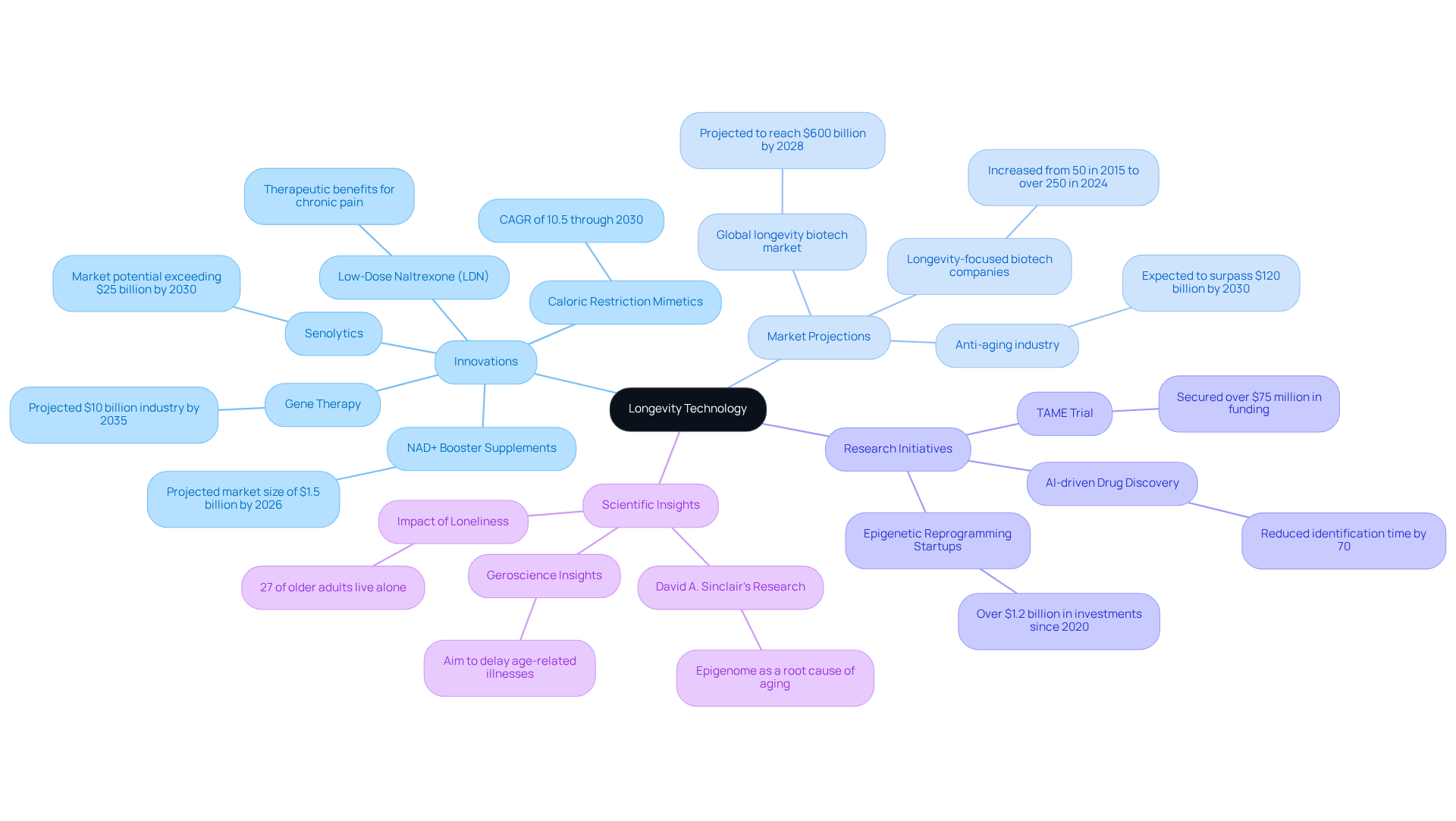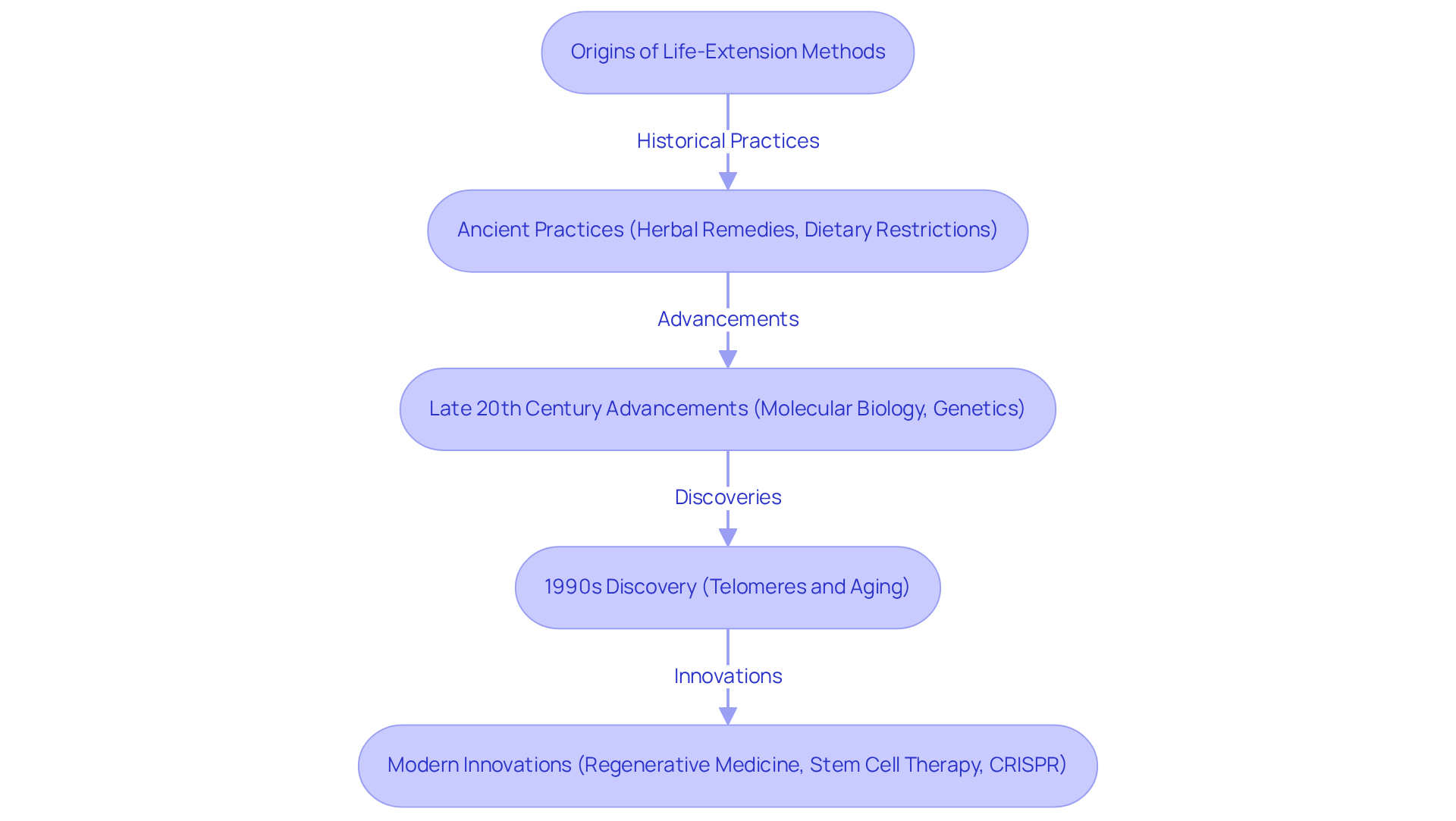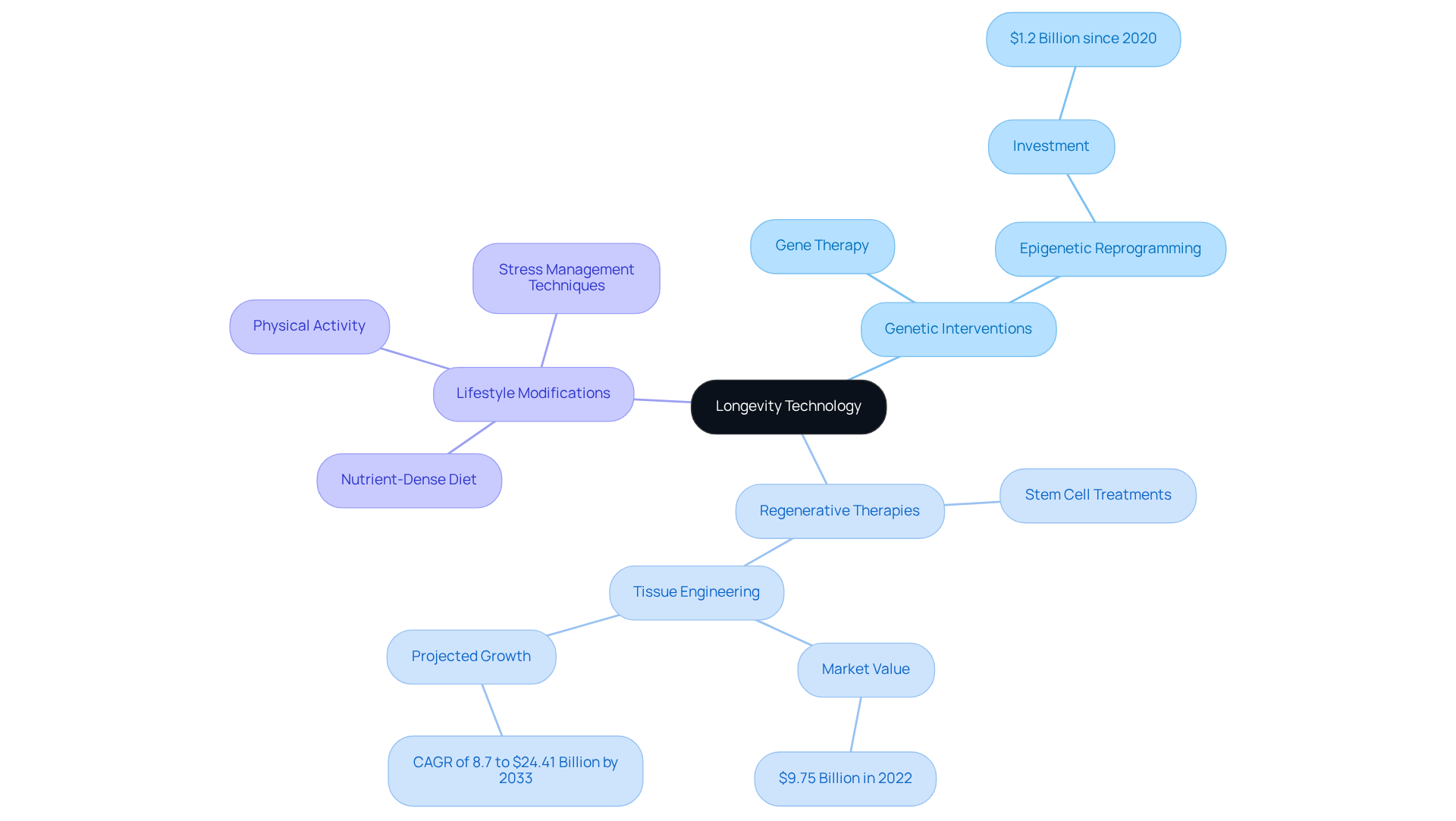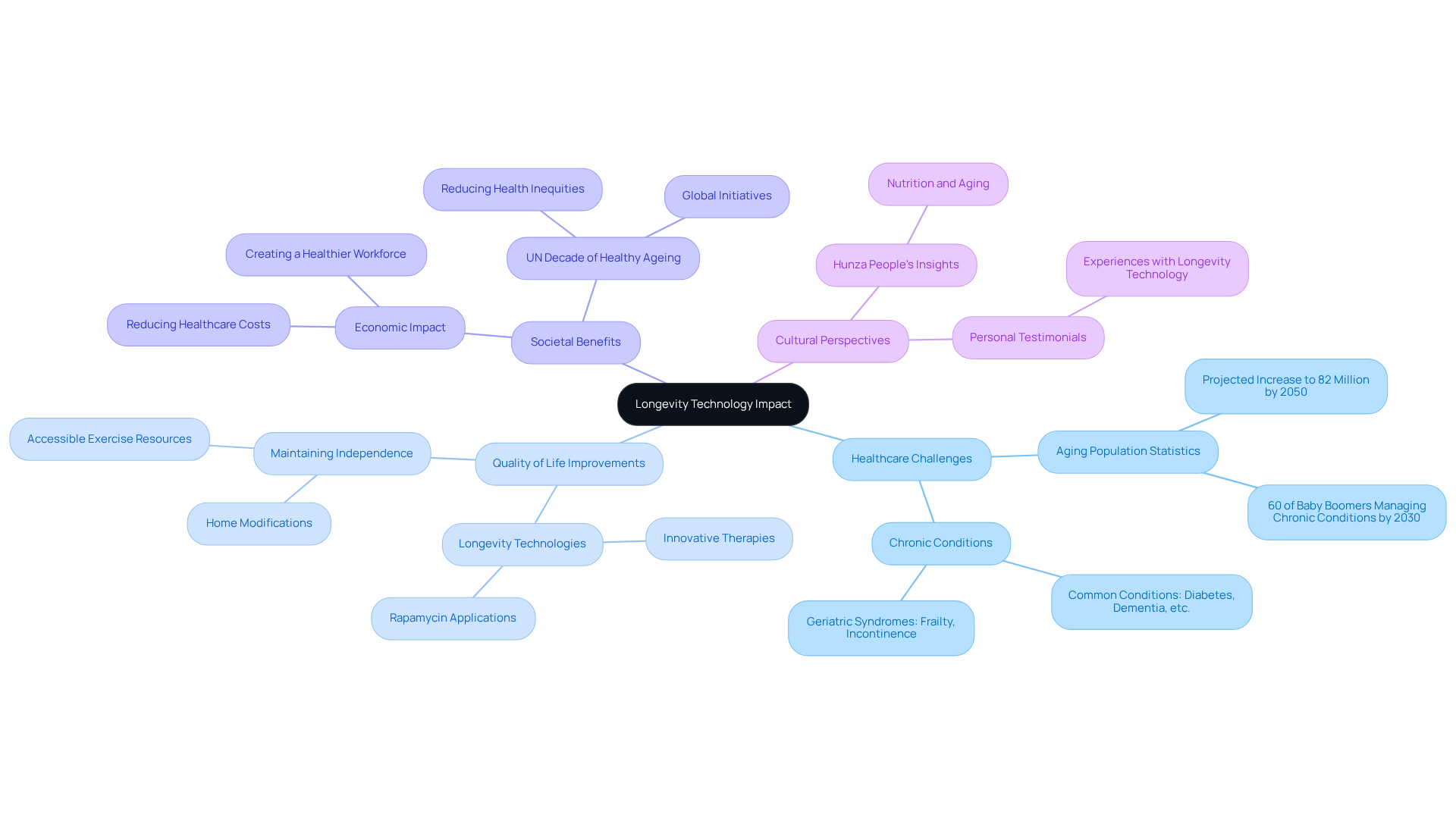Understanding Longevity Technology: Definition and Key Components
Overview
Longevity technology represents a multidisciplinary approach that integrates scientific and technological advancements aimed at extending human lifespan and enhancing health in later years. This field focuses on innovations such as genetic engineering and regenerative medicine. The significance of longevity technology is underscored by its potential to address age-related diseases and improve the quality of life for the aging population. Furthermore, the market for this field is experiencing substantial growth, supported by ongoing research initiatives that promise to unlock new possibilities for healthier aging.
Introduction
Longevity technology is transforming society’s approach to aging by merging scientific innovation with a commitment to enhancing both health and lifespan. This multidisciplinary field includes a variety of advancements—from genetic engineering to regenerative medicine—designed not only to extend life but also to improve the quality of living for older adults. However, as the global population ages and the prevalence of age-related diseases increases, a critical question arises: can these technological breakthroughs genuinely transform the aging experience, or are they simply a glimpse into a future filled with unfulfilled promises?
Defining Longevity Technology: An Overview
Longevity technology represents a multidisciplinary approach that integrates various scientific and technological advancements aimed at extending human lifespan and enhancing health in later years. This dynamic field includes innovations such as genetic engineering, regenerative medicine, and lifestyle interventions, all focused on the biological mechanisms of aging.
A significant development in this area is the use of Low-Dose Naltrexone (LDN), which has gained popularity for its unique effects on the body’s opioid receptors and potential anti-inflammatory properties. At lower doses, LDN can modulate the immune system and decrease inflammation, offering therapeutic benefits for managing chronic neuropathic pain, particularly in conditions like fibromyalgia, Crohn’s disease, multiple sclerosis, and complex regional pain syndrome, where traditional treatments may be insufficient.
By leveraging insights from geroscience, advancements in longevity technology aim to delay the onset of age-related illnesses and enhance the quality of life for older adults. With approximately 24.3% of individuals aged 65 and older reporting fair or poor well-being, the significance of these advancements becomes even more pronounced. As the global population ages, the relevance of longevity technology increases, making it a vital area of focus for researchers, investors, and health advocates alike.
Key advancements include:
- Gene therapy, projected to evolve into a $10 billion industry by 2035.
- The emerging market for senolytics, anticipated to surpass $25 billion by 2030.
- The global longevity biotech market, which generated total revenue of USD 34 million in 2022, underscoring its growth potential.
- The TAME Trial, which has secured over $75 million in funding, exemplifying ongoing research initiatives aimed at addressing the effects of aging as a condition.
- Innovative interdisciplinary approaches, such as Dr. Dituri’s underwater research, providing valuable insights into how distinct environments affect the aging process, including potential influences on telomere length and overall health assessments.
These innovations not only promise to revolutionize healthcare but also highlight the urgent need for effective longevity technology solutions to tackle the challenges posed by an aging population. As David A. Sinclair observes, “One root cause of aging centered on the epigenome – the collection of chemical modifications to a person’s DNA that determine which parts are switched on or off.” This underscores the scientific basis for advancements in life-extension methodologies.

The Evolution of Longevity Technology: Historical Context
The origins of life-extension methods can be traced back to ancient practices focused on prolonging life, such as herbal remedies and dietary restrictions. In the late 20th century, a contemporary age of life extension advancements emerged, driven by innovations in molecular biology and genetics. A landmark discovery in the 1990s was the role of telomeres in cellular aging, which catalyzed extensive research into the biological mechanisms of aging. Furthermore, innovations like regenerative medicine, stem cell therapy, and CRISPR gene editing have revolutionized the field, offering novel strategies to combat age-related decline.
Currently, innovations in longevity technology are recognized as a rapidly expanding sector, attracting significant funding and research initiatives aimed at understanding and enhancing human lifespan. As Jim Oeppen noted, “Predictions of a maximum limit of life expectancy have been broken again and again,” reflecting the ongoing progress in this field. This evolution underscores the dynamic interplay between historical practices and modern advancements in the pursuit of extended life.

Key Components of Longevity Technology: Innovations and Practices
Key components of longevity technology include genetic interventions, regenerative therapies, and lifestyle modifications. Genetic interventions, such as gene therapy and epigenetic reprogramming, aim to correct or enhance biological functions that decline with age. For instance, research indicates that epigenetic reprogramming has attracted over $1.2 billion in investments since 2020, highlighting its potential to reverse signs of aging.
Regenerative therapies, including stem cell treatments and tissue engineering, focus on repairing or replacing damaged tissues and organs. Notably, the global regenerative therapies market was valued at approximately $9.75 billion in 2022 and is projected to grow at a CAGR of 8.7%, reaching $24.41 billion by 2033.
Furthermore, lifestyle changes—such as adopting a nutrient-dense diet rich in animal-based foods, engaging in regular physical activity, and implementing stress management techniques—are essential for enhancing lifespan. Technologies like artificial intelligence and machine learning are increasingly incorporated in longevity technology to tailor interventions and anticipate age-related risks, thereby improving the effectiveness of lifespan strategies.
As the field evolves, the effectiveness of these regenerative therapies in aging populations is becoming more evident, with ongoing clinical trials exploring their potential benefits. Researchers emphasize that advancements in these areas are essential for addressing age-related decline and improving overall healthspan.

The Importance of Longevity Technology: Impacts on Health and Society
The significance of enduring advancements extends beyond personal wellness advantages; it profoundly impacts society as a whole. As populations age, the burden of age-related diseases on healthcare systems intensifies, necessitating innovative solutions to improve health outcomes and reduce costs. By 2030, over 60% of Baby Boomers will be managing multiple chronic conditions, underscoring the healthcare challenges that longevity solutions aim to address. Furthermore, the number of Americans aged 65 and older is projected to rise from 58 million in 2022 to 82 million by 2050—a 47% increase—highlighting the urgent need for effective interventions to support this growing demographic.
Longevity technology innovations offer the potential to enhance the quality of life for older adults, enabling them to maintain independence and vitality. By tackling the biological processes of senescence with longevity technology such as the application of rapamycin, which has shown promise in prolonging lifespan and enhancing healthspan, these innovations can contribute to creating a healthier workforce and alleviating the economic burden associated with chronic illnesses. The incorporation of longevity technology into communal wellness strategies can lead to a fundamental shift in how society addresses aging, promoting a culture that values healthspan as much as lifespan.
Moreover, the UN Decade of Healthy Ageing emphasizes global initiatives aimed at improving the lives of senior citizens, further reinforcing the societal benefits of longevity technology. Common health issues in later life, such as hearing impairment, diabetes, and dementia, are crucial for understanding the healthcare challenges that advancements seek to address.
Incorporating perspectives from the Hunza people, known for their extended lifespan and healthy lifestyle, could enhance this discussion by illustrating the link between nutrition and aging. Additionally, testimonials from individuals who have experienced the benefits of longevity technology would offer relatable insights into its impact.

Conclusion
Longevity technology represents a transformative approach that combines scientific innovation with the goal of extending human life and enhancing well-being in later years. By integrating advancements in genetics, regenerative medicine, and lifestyle modifications, this field focuses not merely on living longer but on living better, aiming to improve health outcomes as populations age.
As we delve into longevity technology, several key components come to light. From gene therapy and regenerative therapies to lifestyle interventions, the potential for these innovations to tackle age-related challenges is immense. The burgeoning market for longevity solutions, highlighted by substantial investments and research initiatives, underscores the urgency of developing effective strategies to support an aging demographic. Various studies and market projections indicate that advancements in this field are set to revolutionize healthcare and enhance the quality of life for millions.
The implications of longevity technology extend beyond individual health benefits. It promises to alleviate the societal burden posed by aging populations, enhance independence, and foster a culture that prioritizes healthspan alongside lifespan. As the world confronts the realities of an aging society, embracing longevity technology can pave the way for a healthier future, underscoring the importance of proactive solutions to age-related challenges. Engaging with these advancements not only prepares society for the demographic shifts ahead but also champions a vision of wellness that values vitality at every stage of life.
Frequently Asked Questions
What is longevity technology?
Longevity technology is a multidisciplinary approach that integrates various scientific and technological advancements aimed at extending human lifespan and enhancing health in later years. It includes innovations such as genetic engineering, regenerative medicine, and lifestyle interventions focused on the biological mechanisms of aging.
What role does Low-Dose Naltrexone (LDN) play in longevity technology?
Low-Dose Naltrexone (LDN) is notable for its effects on the body’s opioid receptors and potential anti-inflammatory properties. At lower doses, LDN can modulate the immune system and decrease inflammation, offering therapeutic benefits for managing chronic neuropathic pain in conditions like fibromyalgia, Crohn’s disease, multiple sclerosis, and complex regional pain syndrome.
How does geroscience contribute to longevity technology?
Geroscience provides insights that help in delaying the onset of age-related illnesses and enhancing the quality of life for older adults, addressing significant health concerns as the global population ages.
What is the current state of the longevity biotech market?
The global longevity biotech market generated total revenue of USD 34 million in 2022, indicating significant growth potential. Key advancements, such as gene therapy and senolytics, are projected to evolve into multi-billion dollar industries in the coming years.
What is the TAME Trial and its significance?
The TAME Trial is a research initiative that has secured over $75 million in funding, aimed at addressing the effects of aging as a condition. It exemplifies ongoing research efforts in the field of longevity technology.
What innovative approaches are being explored in longevity technology?
Innovative interdisciplinary approaches, such as Dr. Dituri’s underwater research, are being explored to understand how distinct environments affect the aging process, including influences on telomere length and overall health assessments.
Why is longevity technology becoming increasingly important?
As approximately 24.3% of individuals aged 65 and older report fair or poor well-being, the advancements in longevity technology become crucial in addressing the challenges posed by an aging population, highlighting the urgent need for effective solutions in healthcare.






